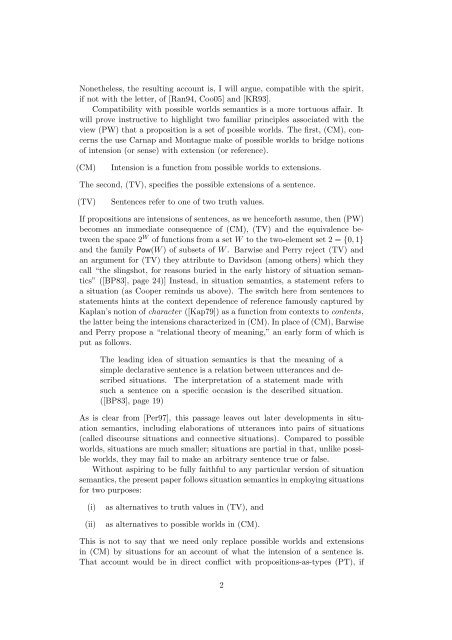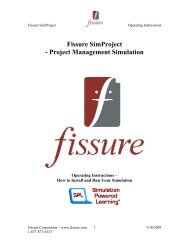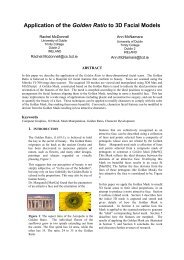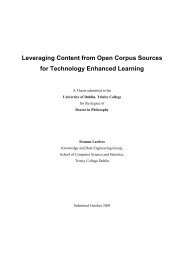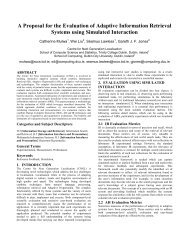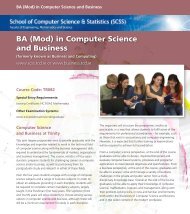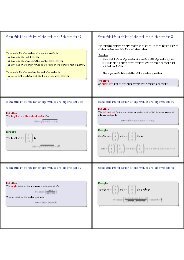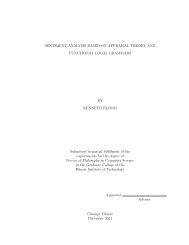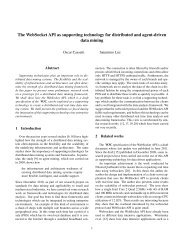Situations from events to proofs 1 Introduction
Situations from events to proofs 1 Introduction
Situations from events to proofs 1 Introduction
You also want an ePaper? Increase the reach of your titles
YUMPU automatically turns print PDFs into web optimized ePapers that Google loves.
Nonetheless, the resulting account is, I will argue, compatible with the spirit,<br />
if not with the letter, of [Ran94, Coo05] and [KR93].<br />
Compatibility with possible worlds semantics is a more <strong>to</strong>rtuous affair. It<br />
will prove instructive <strong>to</strong> highlight two familiar principles associated with the<br />
view (PW) that a proposition is a set of possible worlds. The first, (CM), concerns<br />
the use Carnap and Montague make of possible worlds <strong>to</strong> bridge notions<br />
of intension (or sense) with extension (or reference).<br />
(CM)<br />
Intension is a function <strong>from</strong> possible worlds <strong>to</strong> extensions.<br />
The second, (TV), specifies the possible extensions of a sentence.<br />
(TV)<br />
Sentences refer <strong>to</strong> one of two truth values.<br />
If propositions are intensions of sentences, as we henceforth assume, then (PW)<br />
becomes an immediate consequence of (CM), (TV) and the equivalence between<br />
the space 2 W of functions <strong>from</strong> a set W <strong>to</strong> the two-element set 2 = {0, 1}<br />
and the family Pow(W ) of subsets of W . Barwise and Perry reject (TV) and<br />
an argument for (TV) they attribute <strong>to</strong> Davidson (among others) which they<br />
call “the slingshot, for reasons buried in the early his<strong>to</strong>ry of situation semantics”<br />
([BP83], page 24)] Instead, in situation semantics, a statement refers <strong>to</strong><br />
a situation (as Cooper reminds us above). The switch here <strong>from</strong> sentences <strong>to</strong><br />
statements hints at the context dependence of reference famously captured by<br />
Kaplan’s notion of character ([Kap79]) as a function <strong>from</strong> contexts <strong>to</strong> contents,<br />
the latter being the intensions characterized in (CM). In place of (CM), Barwise<br />
and Perry propose a “relational theory of meaning,” an early form of which is<br />
put as follows.<br />
The leading idea of situation semantics is that the meaning of a<br />
simple declarative sentence is a relation between utterances and described<br />
situations. The interpretation of a statement made with<br />
such a sentence on a specific occasion is the described situation.<br />
([BP83], page 19)<br />
As is clear <strong>from</strong> [Per97], this passage leaves out later developments in situation<br />
semantics, including elaborations of utterances in<strong>to</strong> pairs of situations<br />
(called discourse situations and connective situations). Compared <strong>to</strong> possible<br />
worlds, situations are much smaller; situations are partial in that, unlike possible<br />
worlds, they may fail <strong>to</strong> make an arbitrary sentence true or false.<br />
Without aspiring <strong>to</strong> be fully faithful <strong>to</strong> any particular version of situation<br />
semantics, the present paper follows situation semantics in employing situations<br />
for two purposes:<br />
(i)<br />
(ii)<br />
as alternatives <strong>to</strong> truth values in (TV), and<br />
as alternatives <strong>to</strong> possible worlds in (CM).<br />
This is not <strong>to</strong> say that we need only replace possible worlds and extensions<br />
in (CM) by situations for an account of what the intension of a sentence is.<br />
That account would be in direct conflict with propositions-as-types (PT), if<br />
2


